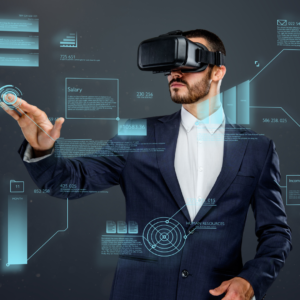Emerging Technologies for Lawyers
Fri, Mar 19th, 2021 | by Miles Mediation and Arbitration | Article | Social Share
By Steve Dunn
In March 2020, when the world went into Covid lockdown, lawyers everywhere learned to use video conferencing technology for the first time. What started as a business necessity soon revealed itself as an essential part of any professional workflow, one that is certain to remain long after the pandemic has ended. With so many of us suddenly forced to use new technology in working from home, it is a good moment to think about what new technologies are on the horizon for lawyers even after business returns to normal.
Virtual Reality (VR)
 Virtual reality is a natural extension of video conferencing. Think of it as like Zoom in a fully immersive, three-dimensional space. To get the full VR experience, users wear special goggles and headphones so your field of view changes when you move your head, and if someone on your left speaks, you hear it in your left ear. Unlike Zoom where you see faces on a screen, VR makes it feel like you are in the same room.
Virtual reality is a natural extension of video conferencing. Think of it as like Zoom in a fully immersive, three-dimensional space. To get the full VR experience, users wear special goggles and headphones so your field of view changes when you move your head, and if someone on your left speaks, you hear it in your left ear. Unlike Zoom where you see faces on a screen, VR makes it feel like you are in the same room.
In its most basic application, VR could bring together individuals from all over the world into a digital conference room for a deposition, or a courtroom for a hearing. Participants have the ability to share documents and interact with three-dimensional objects. Permissions can easily be configured so only authorized individuals can view certain documents, which would appear blurred to others. Lawyers will have the ability to engage in sidebars and private conversations without having to move, and without fear of being overheard.
From there, the sky is the limit in how VR may be used in law practice. Accident reconstructions exhibits could exist in three dimensions, or even a first-person view. Engineers and architects could testify while walking around inside a building with a rending of the blueprint superimposed on the actual structure. Prosecutors could take the jury through a digital representation of the scene of the crime.
This seems like science fiction today, but virtual reality is already commercially viable for video games and video entertainment. It is only a matter of time until VR goes mainstream in business applications, and if the past year has taught us anything, it is that change happens sooner and faster than we expect.
Automated Negotiation
Have you ever negotiated a business deal with a robot? You may not think so, but don’t be so sure. Automated negotiation, originally developed to facilitate cooperation between computers, it already in use by major retailers to negotiate supplier contracts with dozens of variables. The next time you make a settlement offer, a computer may advise your opposing counsel whether to take the deal or press for more.
In its original form, automated negotiation was a process for computers to exchange information while exchanging proposals to accomplish a task. For example, a web browser and a server “negotiate” which file type to display after exchanging information about the available options and the user’s preferences. As the technology evolved, automated negotiation protocols were used in consumer dispute resolution mechanisms for e-commerce websites like Ebay.
More recently, automated negotiation software is being used in contract negotiation involving dozens of terms with varying importance to the parties. Armed with detailed information about an organization’s competencies, preferences, and tolerances, automated negotiators are able to uncover efficiencies likely to go unnoticed by humans. For example, a supplier may be glad to extend a longer warranty in exchange for faster payment, but human negotiators may not think to link these particular terms in a deal with dozens of variables. In this way, the computer can often facilitate a win-win transaction.
As data collection becomes more sophisticated, and data storage becomes less expensive, we can reasonably foresee artificial intelligence and machine learning applied in all sorts of contexts where human negotiators presently rely on the “art of the deal.” Even in something as simple as a settlement negotiation in which money is the only term, automated negotiators may advise human users on the size of each move, when to press for advantage, and whether to accept a final offer. It will not be long until using automated negotiation to help make deals is as common as using a calculator to help do math.
Emotion Analysis
Reading people is an important skill for lawyers. We are constantly in positions of evaluating witnesses’ credibility, persuading skeptical audiences, and sizing up our opponents. Where we generally operate on the basis of life experience, instinct, and common sense, the growing field of emotion analysis uses audio, video, and text to measure an individual’s emotional state.
Zoom is a treasure trove for facial recognition technology. For the first time, millions of people every day are having emotional responses in well lit, full frame view. Emotion analysis software tracks dozens of facial features and measures how they move relative to each other. By comparing this information against a database of known expressions of basic emotions such as anger, disgust, happiness, or surprise, the computer may be able to read the reaction even of someone trying to maintain a poker face.
Similar technology is used to analyze speech patterns and tone of voice, often in evaluating interactions between consumers and call center employees. Text analysis is already in use in co-parenting apps, which may suggest the user rephrase a message she is about to send to a former spouse. While these technologies will never be infallible, they serve as a useful tool in confirming our intuitions or prompting us to consider what might be a faulty assumption.
Emotion analysis undoubtedly will play an important role in jury consulting, providing insight in real time about how witnesses and arguments are being received. In negotiation, the technology may discern whether the gleam in an opponent’s eye was a flash of anger or a signal of delighted surprise. Text analysis may assist us in striking the right tone in emails to opposing counsel. However we may use the technology ourselves, it is safe to assume our own facial expressions, voice, and written words will soon be analyzed by our business contacts, if they are not already.
ABOUT STEVE DUNN
 Steve spent his entire 20-year litigation career at one firm, the Charlotte employment law boutique Van Hoy, Reutlinger, Adams & Dunn. His clients ranged from individual executives to Fortune 500 companies in virtually every industry, including banking, education, manufacturing, technology, construction, marketing, motorsports, and public sector clients throughout North Carolina. Steve has extensive experience litigating all forms of employment discrimination in the North Carolina federal courts and the Fourth Circuit Court of Appeals.
Steve spent his entire 20-year litigation career at one firm, the Charlotte employment law boutique Van Hoy, Reutlinger, Adams & Dunn. His clients ranged from individual executives to Fortune 500 companies in virtually every industry, including banking, education, manufacturing, technology, construction, marketing, motorsports, and public sector clients throughout North Carolina. Steve has extensive experience litigating all forms of employment discrimination in the North Carolina federal courts and the Fourth Circuit Court of Appeals.

